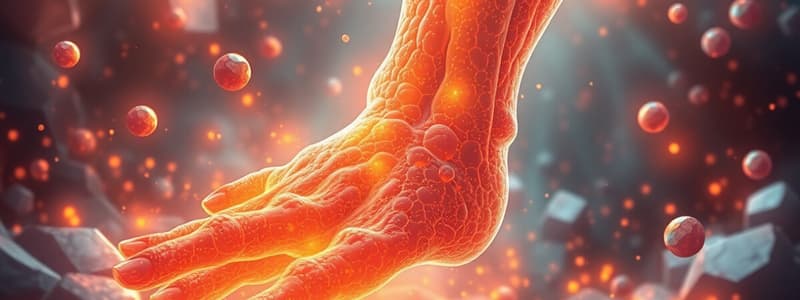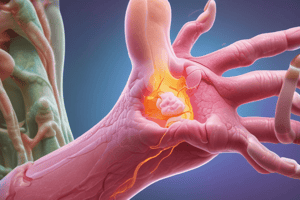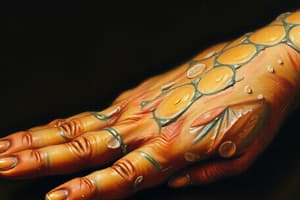Podcast
Questions and Answers
Which of the following is the primary goal during the intercritical gout phase?
Which of the following is the primary goal during the intercritical gout phase?
- Prophylaxis of another gout flare (correct)
- Dissolving uric acid crystals
- Controlling severe crippling disease
- Managing pain and inflammation
Why is titrating allopurinol doses important when initiating urate-lowering therapy?
Why is titrating allopurinol doses important when initiating urate-lowering therapy?
- To prevent Allopurinol Hypersensitivity Syndrome (AHS) (correct)
- To minimize gastrointestinal side effects
- To avoid potential interactions with other medications
- To enhance the drug's effectiveness in lowering uric acid levels rapidly
Which of the following conditions is associated with an increased risk of developing hyperuricemia and gout?
Which of the following conditions is associated with an increased risk of developing hyperuricemia and gout?
- Hypotension
- Excess alcohol intake (correct)
- Regular exercise
- High-fiber diet
In managing gout, when is initiating urate-lowering therapy (ULT) during a gout flare generally considered?
In managing gout, when is initiating urate-lowering therapy (ULT) during a gout flare generally considered?
Which of the following dietary recommendations is most appropriate for preventing future gout attacks?
Which of the following dietary recommendations is most appropriate for preventing future gout attacks?
When are uric acid levels most useful in the diagnosis and management of gout?
When are uric acid levels most useful in the diagnosis and management of gout?
Which patient population is at a particularly elevated risk of Allopurinol Hypersensitivity Syndrome (AHS)?
Which patient population is at a particularly elevated risk of Allopurinol Hypersensitivity Syndrome (AHS)?
Which of the following treatment options warrants caution for patients with a history of cardiovascular disease?
Which of the following treatment options warrants caution for patients with a history of cardiovascular disease?
What is the most common initial presentation of a gouty flare?
What is the most common initial presentation of a gouty flare?
Which of the following is a characteristic feature of tophaceous gout?
Which of the following is a characteristic feature of tophaceous gout?
Flashcards
Gout
Gout
Inflammatory disease with uric acid or urate crystal deposits in joints, soft tissues, and renal tissues.
Asymptomatic hyperuricemia
Asymptomatic hyperuricemia
Elevated serum urate levels (>400 umol/L) without clinical manifestations.
Gouty Flare
Gouty Flare
Quick onset of excruciating pain and inflammation (85% start off as monoarticular, big toe most common).
Intercritical Gout
Intercritical Gout
Signup and view all the flashcards
Tophi/Tophaceous Gout
Tophi/Tophaceous Gout
Signup and view all the flashcards
Overproduction of uric acid
Overproduction of uric acid
Signup and view all the flashcards
Under-secretion of uric acid
Under-secretion of uric acid
Signup and view all the flashcards
NSAIDs for Gout
NSAIDs for Gout
Signup and view all the flashcards
Colchicine
Colchicine
Signup and view all the flashcards
Allopurinol
Allopurinol
Signup and view all the flashcards
Study Notes
Gout
- Gout is an inflammatory disease
- It is characterized by uric acid or urate crystal deposits in joints, soft tissues like cartilage, and renal tissues like the glomeruli
- These deposits cause severe arthritis or joint pain
Tophi/Tophaceous Gout
- These are chronic complications
- They present as large, visible bumps or nodules in soft tissue
- Consist of uric acid crystals which leads to pain and inflammation
Other Complications of Hyperuricemia
- Uric acid nephrolithiasis, which means kidney stones
- Nephropathy
Gouty Arthritis
Asymptomatic Hyperuricemia
- Elevated serum urate levels indicate this, specifically levels higher than 400 umol/L
- There are no clinical manifestations present
Gouty Flare
- This is a quick onset of excruciating pain and inflammation
- It commonly happen in the night or early morning
- 85% of attacks start off as monoarticular, and the big toe is the most common site
- It is also known as a gout attack or flare up
Intercritical Gout
- This phase occurs after the first gout flare
- The individual is asymptomatic during this time
- The main goal is prophylaxis of another gout flare
Chronic Gouty Arthritis
- Typically develops 12 years after onset, with only 2% of patients experiencing severe crippling disease
- Therapy aims to control pain and inflammation
Pathophysiology
- Uric acid is the final waste product of purine metabolism and is excreted renally
- Gout is a condition where excess uric acid accumulates, forming urate crystals
- These crystals deposit in joints, soft tissues like tendons or cartilage, or renal tissues like glomeruli
- Risk can be increased by overproduction of uric acid or under-secretion of uric acid
- Overproduction: higher purine intake, abnormal enzyme function, and dysregulation
- Under-secretion: reabsorption of uric acid in the kidney potentially due to dehydration
Foods High in Purines
- Red meats
- Beer
- Fish
- Shellfish
Risk Factors for Hyperuricemia and Gout
- Excess alcohol intake
- Atherosclerosis
- Chronic kidney, glomerular, and interstitial renal disease
- Diabetes
- Hyperlipidemia
- Hypertension
- Ischemic heart disease
- Lead intoxication
- Metabolic syndrome
- Myeloproliferative disorders and some cancers
- Obesity
- History of urolithiasis
- Genetic and/or acquired causes of uric acid production, although this is rare
Goals of Therapy
- Terminate the acute attack of arthritis
- Prevent recurrence
- Prevent or reverse complications
- Treat associated disorders
- Minimize side effects associated with drug therapy
Diagnosis
- Classical symptoms of gout is usually enough for accurate diagnosis
- Aspiration of synovial fluid is needed for atypical signs/symptoms,
- Screening for other comorbidities
- Radiographs are utilized for diagnosing chronic gout only
- Uric acid levels are important for monitoring, but not for diagnosis
Monitoring Uric Acid Levels
- People with high uric acid levels may have no symptoms and should not be treated
- Uric acid levels are normally elevated during an acute attack
Preventing Future Gout Attacks
- Avoid alcohol during acute attacks
- Limit intake to no more than 1-2 drinks daily for maintenance
- Maximum of 2 in men and 1 in women daily
- Avoid drinks high in fructose
- Avoid foods high in purines, such as sweetbreads, liver, and kidney
- Limit consumption of meat like beef, lamb, pork, and seafood
- Reduce intake of naturally sweet fruit juices, salt, table sugar, and sweetened beverages
- Encourage regular exercise to maintain a healthy weight
- Consume non-fat dairy products and vegetables, and stay hydrated
- Smoking cessation
Treating Gout
NSAIDs
- NSAIDs like indomethacin, naproxen, and ibuprofen are the most common
- All non-salicylate NSAIDs are effective
- Side effects: gastric ulcers, worsening hypertension, fluid retention, and edema
- Use with caution in those with cardiovascular disease, history of ulcers, or renal disease
Colchicine
- Antimitotic that mitigate the inflammatory response by neutrophils
- Can contribute to gout symptoms
- Side effects: Primarily GI, can cause nausea, vomiting, and diarrhea, this resolves with dose reduction and drug discontinuation),
- Chronic side effects include alopecia, bone marrow suppression, or neuropathy
- Colchicine is a major substrate of CYP3A4 and P-glycoprotein
- Avoid if CrCl is less than 30 mL/min
Corticosteroids
- These include Prednisone or prednisolone
- Can use via Intra-articular or intramuscular injection
- Useful for use in patients who cannot tolerate oral corticosteroids
- Side effects: hypertension, hyperglycemia, osteoporosis, mood changes, weight gain, or Cushing's Syndrome
Note
- Colchicine and NSAIDs are not recommended in severe renal impairment
- Oral corticosteroids should be considered for patients with severe renal impairment
Urate-Lowering Therapies
- These are therapies to lower uric acid to prevent flares in patients with established gout
- They are not indicated in asymptomatic hyperuricemia
Allopurinol
- Allopurinol (Xanthine Oxidase Inhibitor)
- 1st line agent: start at a low dose and titrate slowly to serum levels less than 360 µmol/L or to "target symptoms"
- Titration is key to prevent Allopurinol Hypersensitivity Syndrome AHS
- AHS is a severe potentially life-threatening condition that can present as Steven-Johnson's syndrome, toxic epidermal necrolysis, and systemic organ diseases
- Risk factors for AHS associated with allopurinol: initiating at high dose, renal impairment, positive for HLA-B*5801 allele (allele present in Han Chinese, Thai, Korea, and African American patients, or concomitant diuretic use
Febuxostat
- Febuxostat (Xanthine Oxidase Inhibitor)
- Used when allopurinol is ineffective, not tolerated, or due to patient specific factors
- Unlike allopurinol, it does not require renal dosage adjustments
- Increases the risk of CVD-related deaths in gout patients with established CVD
Urate-Lowering Therapy ULT
- Allopurinol is the 1st line therapy
- Start at a low dose then titrate to target
- Concomitant anti-inflammatory prophylaxis therapy (e.g., colchicine, NSAIDs, prednisone/prednisolone)s
The following patients are strongly recommended to start ULT prophylaxis
- Patients with more than 2 gout flares per year
- Patients with more than 1 subcutaneous tophi
- Evidence of radiographic damage seen with any imaging modality
The following patients are conditionally recommended to start ULT prophylaxis
- The decision to start is based on specific patient characteristics for example established CVD
- Patients with infrequent flares greater than 1 flare but less than 2 per year
- Patients with moderate-severe chronic kidney disease which is stage 3 or more
- Patients with serum uric acid levels more than 535 umol/L
- Patients with urolithiasis which means kidney stones
- When the decision is made that ULT is indicated while the patient is experiencing a gout flare, consider starting ULT during the gout flare versus starting ULT after the gout flare has resolved and must be advised that this can worsen the flare.
Studying That Suits You
Use AI to generate personalized quizzes and flashcards to suit your learning preferences.




